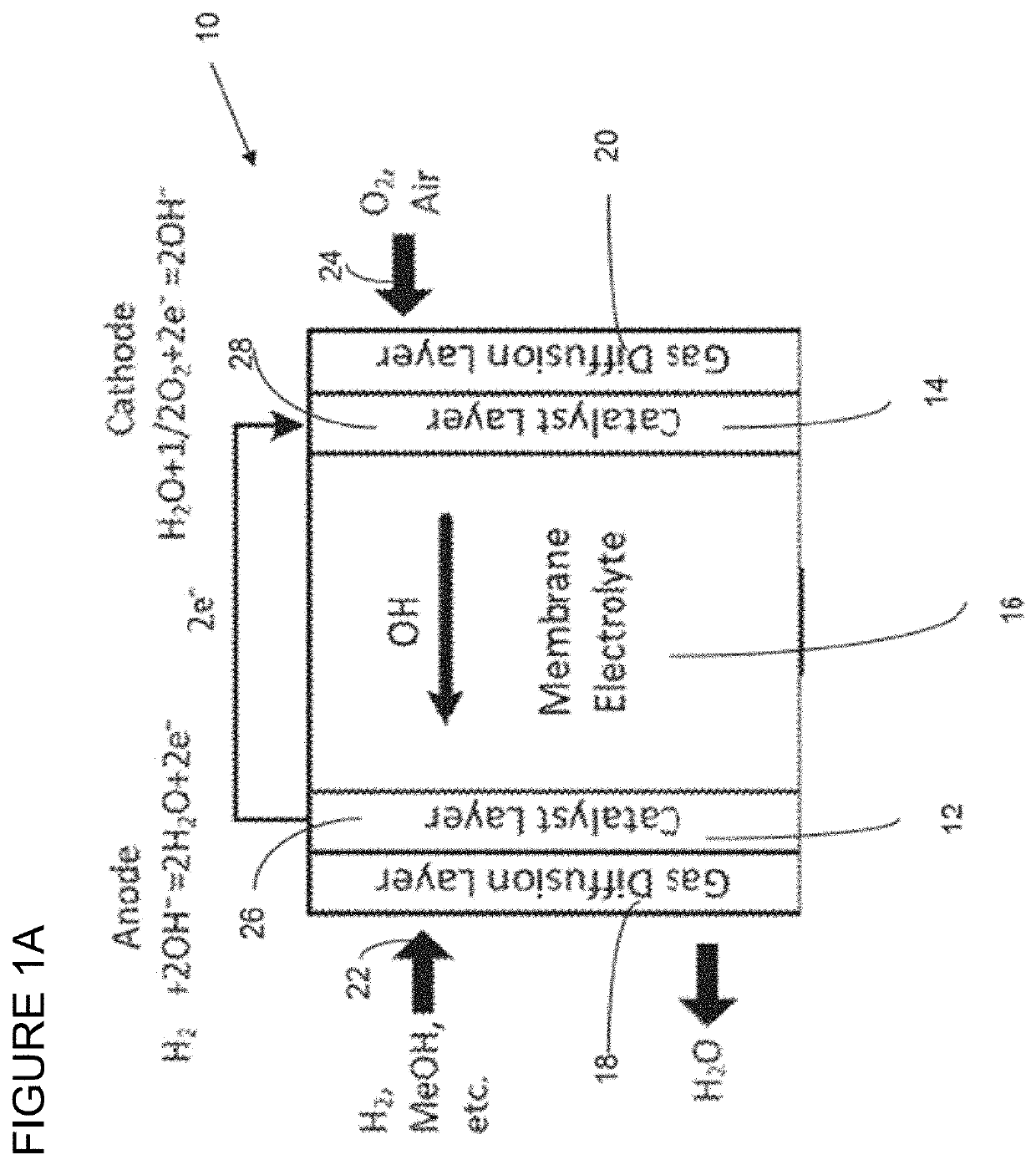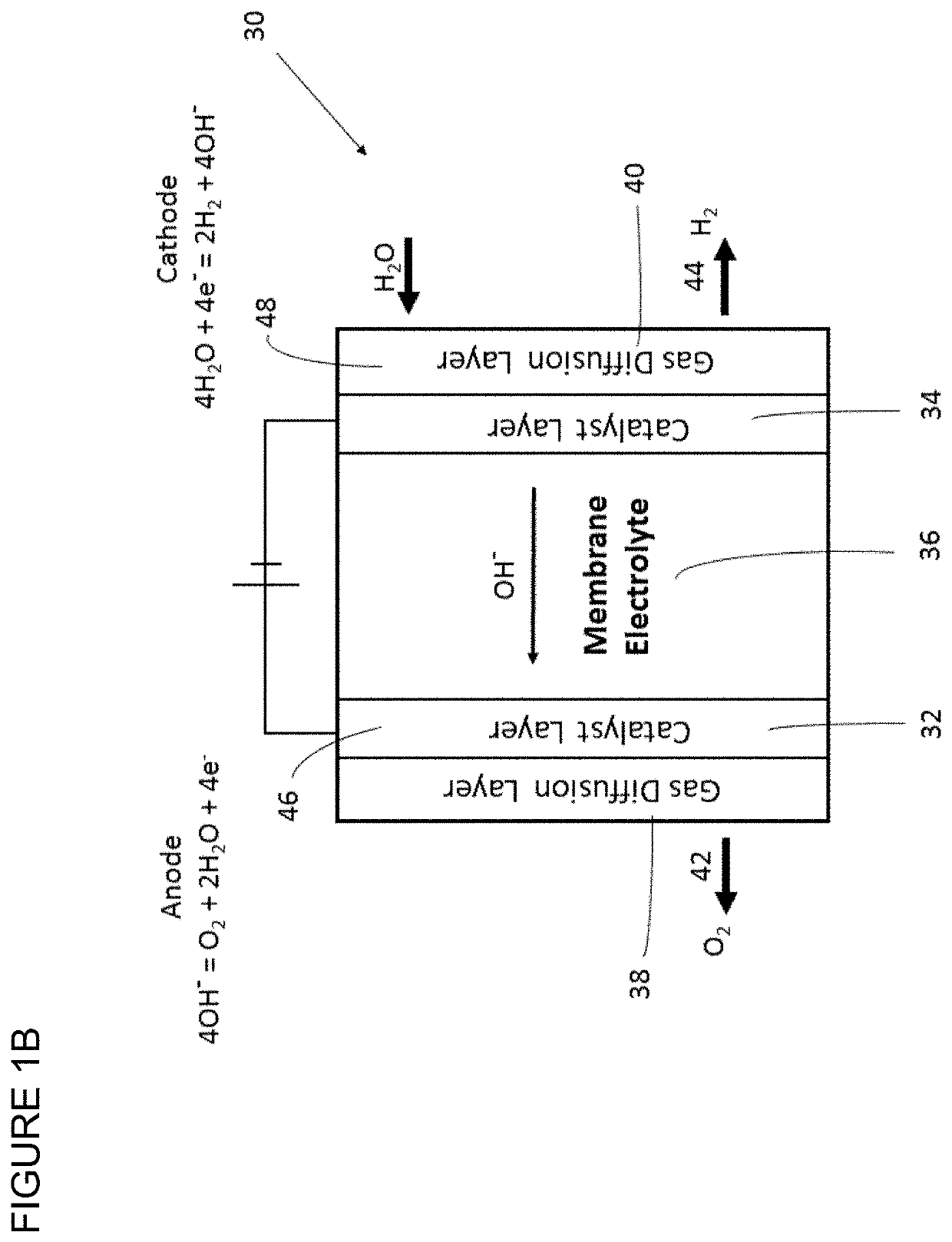Polymers having stable cationic pendant groups for use as anion exchange membranes
- Summary
- Abstract
- Description
- Claims
- Application Information
AI Technical Summary
Benefits of technology
Problems solved by technology
Method used
Image
Examples
example 1
[0193]An imidazolium-tethered poly(aryl alkylene) polymer was prepared from 7-bromo-1,1,1-trifluoroheptan-2-one, 1,1,1-trifluoroacetone and biphenyl (referred to as BP-CF3-IM-x, wherein x is the mole ratio of 7-bromo-1,1,1-trifluoroheptan-2-one to biphenyl and is from 1 to 100). BP-CF3-IM-x was prepared by three major steps: (1) synthesis of a bromide-functionalized polymer, (2) synthesis of an imidazolium-functionalized polymer, and (3) membrane casting and hydroxide exchange. The reaction scheme is depicted below, wherein n is the number of repeat units in the polymer:
[0194](1) Synthesis of the bromide-functionalized polymer (BP-CF3-Br-1).
[0195]To a 100 mL three-necked flask equipped with overhead mechanical stirrer, 7-bromo-1,1,1-trifluoroheptan-2-one (3.000 g, 12.1 mmol) and biphenyl (1.560 g, 10.1 mmol) were dissolved into methylene chloride (6.7 mL). Trifluoromethanesulfonic acid (TFSA) (6.7 mL) were then added dropwise over 30 minutes at 0° C. Thereafter, the reaction was con...
example 2
[0210]An imidazolium-tethered poly(aryl alkylene) polymer was prepared from 7-bromo-1,1,1-trifluoroheptan-2-one, 1,1,1-trifluoroacetone and p-terphenyl (referred to as TP-CF3-IM-x, wherein x is the mole ratio of 7-bromo-1,1,1-trifluoroheptan-2-one to p-terphenyl and is from 1 to 100). TP-CF3-IM-x was prepared by three major steps: (1) synthesis of a bromide-functionalized polymer, (2) synthesis of an imidazolium-functionalized polymer, and (3) membrane casting and hydroxide exchange. The reaction scheme is depicted below, wherein n is the number of repeat units in the polymer:
[0211](1) Synthesis of a bromide-functionalized polymer (TP-CF3-Br-1).
[0212]To a 100 mL three-necked flask equipped with overhead mechanical stirrer, 7-bromo-1,1,1-trifluoroheptan-2-one (3.600 g, 14.6 mmol) and p-terphenyl (2.797 g, 12.1 mmol) were dissolved into methylene chloride (30 mL). Trifluoromethanesulfonic acid (TFSA) (30 mL) was then added dropwise over 30 minutes at 0° C. Thereafter, the reaction was...
example 3
[0223]Another imidazolium-tethered poly (aryl alkylene) polymer is prepared from 7-bromo-1,1,1-trifluoroheptan-2-one, 1,1,1-trifluoroacetone and m-terphenyl (referred to as mTP-CF3-IM-x, wherein x is the mole ratio of 7-bromo-1,1,1-trifluoroheptan-2-one to biphenyl and is from 1 to 100). mTP-CF3-IM-x is prepared by three major steps similar to that of TP-CF3-IM-x: (1) synthesis of a bromide-functionalized polymer, (2) synthesis of a imidazolium-functionalized polymer, and (3) membrane casting and hydroxide exchange. The reaction scheme is depicted below, wherein n is the number of repeat units in the polymer
PUM
| Property | Measurement | Unit |
|---|---|---|
| Temperature | aaaaa | aaaaa |
| Temperature | aaaaa | aaaaa |
| Temperature | aaaaa | aaaaa |
Abstract
Description
Claims
Application Information
 Login to View More
Login to View More - R&D Engineer
- R&D Manager
- IP Professional
- Industry Leading Data Capabilities
- Powerful AI technology
- Patent DNA Extraction
Browse by: Latest US Patents, China's latest patents, Technical Efficacy Thesaurus, Application Domain, Technology Topic, Popular Technical Reports.
© 2024 PatSnap. All rights reserved.Legal|Privacy policy|Modern Slavery Act Transparency Statement|Sitemap|About US| Contact US: help@patsnap.com










